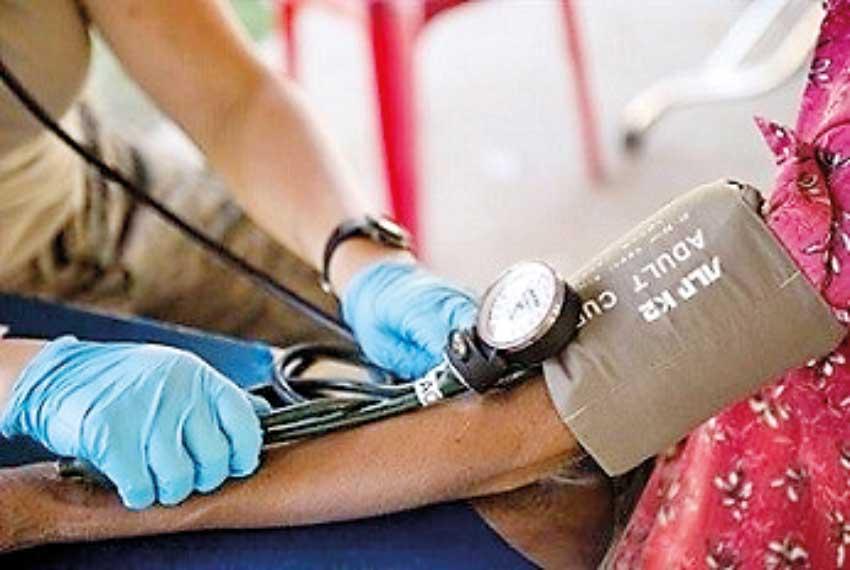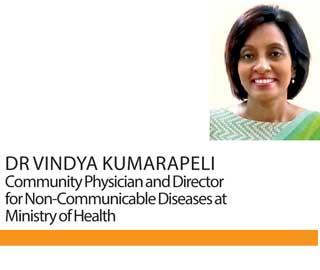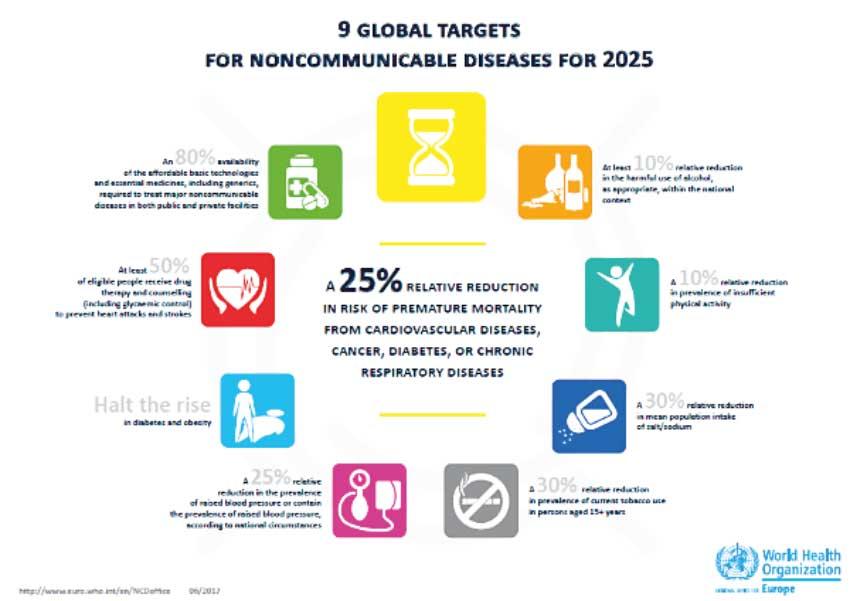21 May 2022 - {{hitsCtrl.values.hits}}

 Non-communicable diseases (NCDs) are said to be the leading cause of premature deaths in Sri Lanka. Diabetes, cardiovascular, cancer and chronic respiratory diseases, are identified as the main NCDs. As such, a Multi-sectoral Action Plan for the Prevention and Control of NCDs has been drafted with several targets to be achieved by 2025.
Non-communicable diseases (NCDs) are said to be the leading cause of premature deaths in Sri Lanka. Diabetes, cardiovascular, cancer and chronic respiratory diseases, are identified as the main NCDs. As such, a Multi-sectoral Action Plan for the Prevention and Control of NCDs has been drafted with several targets to be achieved by 2025.
In an interview with the Daily Mirror Health Capsule, Consultant Community Physician and Director for Non-Communicable Diseases at Ministry of Health Dr. Vindya Kumarapeli explained the challenges in preventing and controlling NCDs, interventions by the Health Ministry and the importance of wellness.
Excerpts:
Q What are the most common NCDs in Sri Lanka and the current trends on NCDs?
Non-Communicable Diseases includes cardiovascular diseases- (heart attacks, Stroke), Diabetes, Chronic lung diseases- (Asthma, Bronchiectasis, COPD), Cancers, Chronic Kidney Disease.
In year 2016, 83% of the total deaths in the country were due to NCDs. 
According to the Annual health bulletin, In the year 2019, 50.7% of the deaths in government hospitals were due to NCDs. Ischemic heart disease (IHD) has been the number 01 leading cause of death in government hospitals during the last decade.
According to the NCD risk factor survey STEPS 2015 7.4% of adults surveyed (18-69 years) had high blood glucose while 9% of the adults had high cardiovascular disease risk or had a cardiovascular disease. One fourth of the population had above normal total cholesterol levels. 26% were having high blood pressure or were on treatment for it.
In the year 2016, of the total 464 billion of current health expenditure, majority (36%) was spent on the management of NCDs.
Q NCDs are the highest-ranking cause of premature death in Sri Lanka, what have been the major risk factors driving NCDs in Sri Lanka? Who are the most vulnerable groups? What about youth and children?
NCDs are related to unhealthy lifestyle (Tobacco and Alcohol use, unhealthy diet, Physical inactivity).
According to the NCD risk factor survey STEPS 2015, 30.4% of adult Sri Lankans are not adequately physically active. Around 73% do not consume recommended servings of fruit or vegetables per day. Nearly one third of Sri Lankan males smoke tobacco while around 20% are daily smokers. Around 18% Sri Lankan adults currently consume alcohol.
In Sri Lanka, out of the NCD deaths, nearly half (45%) are under the age of 70 (54% of male NCD deaths and 36% of female NCD deaths).
Q Why is prevention and control of NCDs a much more complex task compared to tackling communicable diseases?
Prevention and control of NCDs is a much more complex task compared to tackling communicable diseases. There are several reasons for this complexity. Prevention of NCDs include reduced exposure to NCD risk factors; exposure of the population to NCD risk factors throughout the life-course. i.e. policy and regulatory measures to introduce population based strategies to reduce risk factors for NCDs as well as adherence to a healthy lifestyle i.e. individual measures are vital.

Q Recognizing the devastating impact of NCDs on health and development, what has been the severity of NCDs in Sri Lanka?
Prevention and control strategies need to be prioritized and targeted to reduce premature mortality caused by NCDs, as it has a devastating impact on labour productivity and economic development.
This cost of NCDs in terms of lives and livelihoods lost is coupled with a staggering economic impact, both as a result of healthcare expenditure as well as the negative impact on productivity
Poverty is closely linked with NCDs. The rapid rise in NCDs is predicted to impede poverty reduction initiatives particularly by increasing household costs associated with health care.
Vulnerable and socially disadvantaged people get sicker and die sooner than people of higher social positions, especially because they are at greater risk of being exposed to harmful products, such as tobacco, unhealthy dietary practices and have limited access to health services.
Tackling NCDs early on with better prevention and treatments would significantly spare poor people the crushing burden of poor health, lost wages, disabilities, and pre-mature death.
Q Are there any national programs or any existing government strategies to enact and implement NCD policies?
Ministry of Health in close collaboration with relevant Ministries and other stakeholders developed the National Multisectoral Action Plan for the Prevention and Control of Noncommunicable Diseases 2016- 2020 underpinned by a set of national targets consistent with global NCD targets to be attained by 2025. They are:
A 25% relative reduction in the overall mortality from cardiovascular diseases, cancer, diabetes, or chronic respiratory diseases National NCD target
At least 10% relative reduction in the harmful 48 use of alcohol. National NCD target
A 10% relative reduction in prevalence of insufficient physical activity. National NCD target
A 30% relative reduction in mean population intake of salt/sodium. National NCD target
A 30% relative reduction in prevalence of current tobacco use in persons aged 15+ years. National NCD target
A 25% relative reduction in the prevalence of raised blood pressure. National NCD target
Halt the rise in diabetes and obesity. National NCD target
At least 50% of eligible people receive drug therapy and counselling (including glycaemic control), to prevent heart attacks and strokes.
An 80% availability of the affordable basic technologies and essential medicines, including generics, required to treat major NCDs in both public and private facilities.
Q Tell us about the Health Ministry NCD Unit’s ongoing interventions and plans in reducing the communal spread of NCDs, targeting children, youth and civil society members.
Directorate of Non-communicable diseases in collaboration with the other health and non-Health sector partners leads prevention and control activities at various settings and community.
Healthy Lifestyle Centres (HLCs) were established across the island to screen the general population for NCDs and their risk factors and to promote lifestyle modifications. The main objective of screening is to identify behavioural and intermediate risk factors and to refer for early intervention and management. the 35 years and above age group is considered as the target population for screening, which is around 40% of the population. In addition, persons between the ages of 20-34 years having selected risk factors, are also eligible for the screening. Clients are screened for behavioural risk factors, and intermediate risk factors (blood glucose and cholesterol levels, blood pressure, obesity) for Non-communicable Diseases and the risk for a Cardiovascular event within 10 years is assessed.
NCD unit has taken initiatives to establish tobacco free zones, at community, workplaces, schools settings. The unit is also involved in training and capacity building of the staff at the HLC for Tobacco cessation counselling.
The Directorate of NCD is concerned with activities pertaining to advocating for prioritizing and integrating promotion of physical activity into policies across all governmental and private sector organizations. The Unit conducts training of primary HLC staff for promotion of physical activity among the HLC clients and in the community. Further, the unit coordinates activities related to mobilizing the civil societies and private sector to empower the Sri Lankan community to be more physically active.
The Unit conducts public awareness programmes on reductions of dietary salt, sugar and trans-fat through mass media and social media. Making public aware on interpretation of the color coding for sugar level in sugar sweetened beverages and color coding for salt-sugar-fat in solid and semisolid packaged food is being done through media.
Q Let’s talk about the importance of wellness and how can diagnosis and prevention be done during this challenging period.
Failure to act on NCDs and their risk factors has been shown to put populations, health systems and the economy at increased risk of major impacts from epidemics such as COVID-19.
Management of lifestyle related risk factors for NCDs is the key to prevent the development NCDs. i.e. changes in lifestyle with respect to a healthy diet, increased physical activities, cessation of smoking, and alcohol. High in starch, sugar, salt, fat/oil, less fruits and vegetables lead to development of NCDs and makes it difficult to keep NCDs under control.
Furthermore, screening for NCDs early i.e. 35 years of age though feeling apparently healthy will help to diagnose NCDs among adults and it will lead to a better control of risk factors NCDs. People living with NCDs should adhere to a healthy lifestyle while maintaining optimal control of their disease by following medical advice and taking their prescribed medicines. Maintaining optimal blood glucose level, keeping blood pressure under control is important.
20 Dec 2024 2 hours ago
20 Dec 2024 3 hours ago
20 Dec 2024 4 hours ago
20 Dec 2024 5 hours ago
20 Dec 2024 5 hours ago